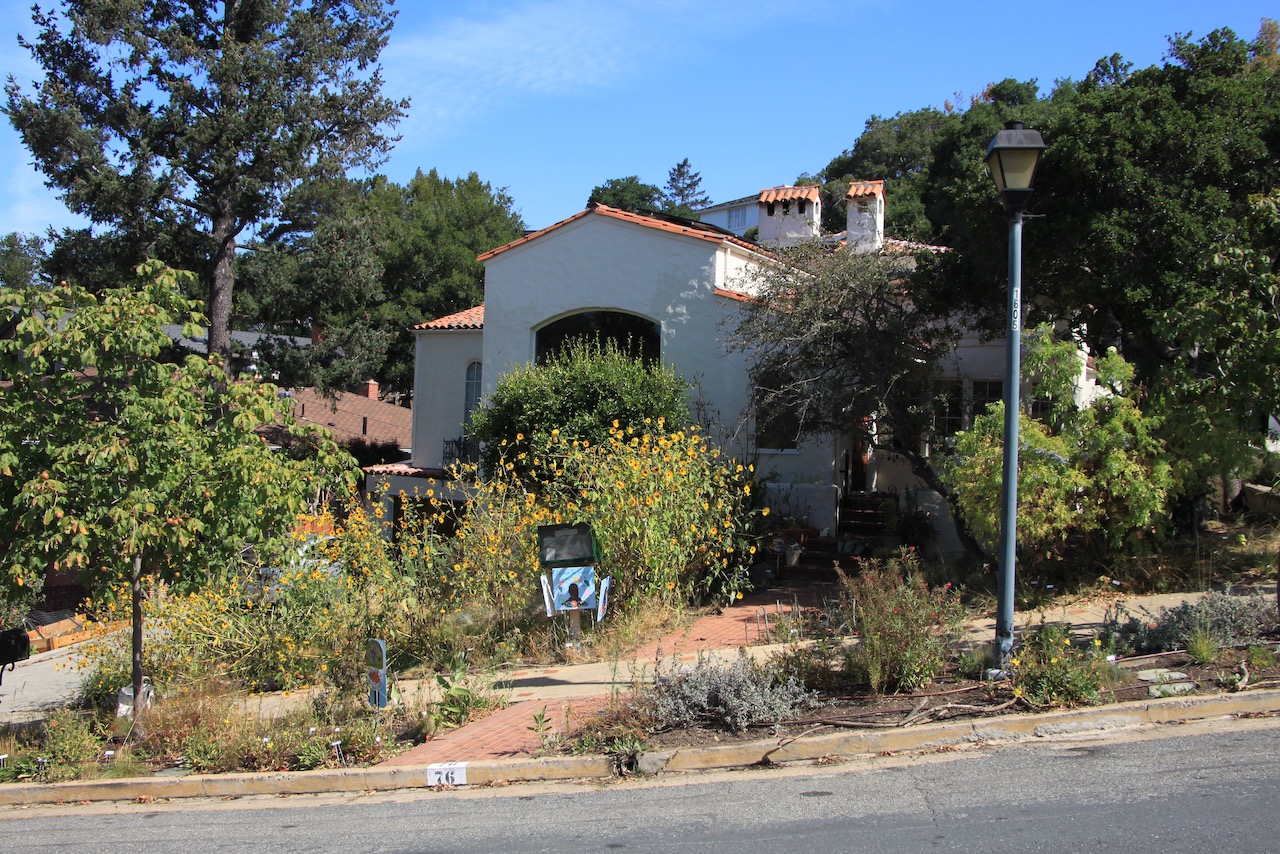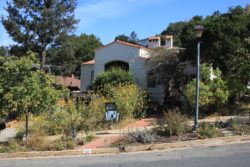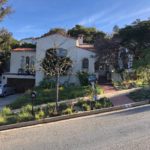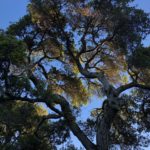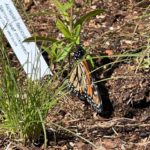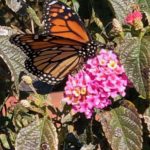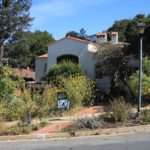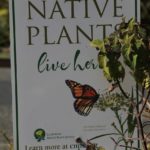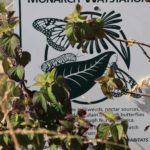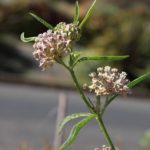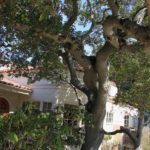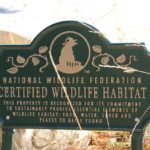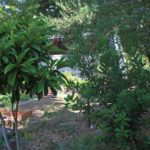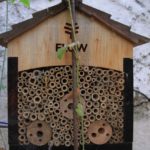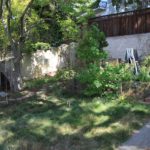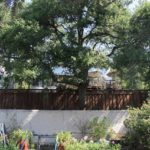NOTE: This garden is accessed via stairs, and has sloping ground and uneven steps. It should not be visited by those with balance issues.
Hope’s goal was to inspire a love of nature in her children by bringing nature home—and the lawn clearly wasn’t bringing the birds, bees, and butterflies in. Hope, who designed and installed the garden, started by experimenting on the parking strip before launching into the rest of the garden. Lawn removal and irrigation rebates from EBMUD helped to pay for the plants and Netafim drip irrigation system in the front garden. (Did you know that EBMUD is now offering a super-rebate of $1.50 a square foot—double the usual amount—if you install a native plant garden?)
The pandemic was a time of creativity in the Salzer household as hardworking Hope replaced the front and back lawns with an exuberant array of wildflowers (baby blue eyes, buttercups, gilia, clarkia, meadowfoam and more); interesting groundcovers (among them is the deliciously-scented yerba buena); a plethora of herbaceous plants (including the aromatic coyote mint, and snowberries, gumplant, and our vibrantly golden native sunflower); and perennials, such as currants (evergreen, golden, wax, and chaparral), ocean spray, bee plant, and huckleberry, among many others. With more than 140 species of native plants, something is in bloom nearly year-round in this diverse landscape.
 In addition to receiving a rebate for removing their front lawn, Hope and Larry were delighted to receive a “Super Rebate” of double the normal amount – for a total of $1.50 a square foot – from EBMUD for replacing irrigated lawn with native plants. Hope reports “It was easy to apply for the Super Rebate online and the rebate we received, as an EBMUD bill credit, will pay for over four months of our family’s water bill. Moreover, compared to the lawn, the native grasses look great, support many more wildlife species, need much less water (once established), help prevent soil erosion, and can be mowed occasionally or left as a longer, undulating, billowy meadow punctuated with native wildflowers. I planted a mixture of red fescue ‘Molate, oatgrass, Idaho fescue and June grass with a sprinkling along the fence edge of the larger-leaved squirrel tail and California brome. I love the garden, and neighbors admire it, too!”
In addition to receiving a rebate for removing their front lawn, Hope and Larry were delighted to receive a “Super Rebate” of double the normal amount – for a total of $1.50 a square foot – from EBMUD for replacing irrigated lawn with native plants. Hope reports “It was easy to apply for the Super Rebate online and the rebate we received, as an EBMUD bill credit, will pay for over four months of our family’s water bill. Moreover, compared to the lawn, the native grasses look great, support many more wildlife species, need much less water (once established), help prevent soil erosion, and can be mowed occasionally or left as a longer, undulating, billowy meadow punctuated with native wildflowers. I planted a mixture of red fescue ‘Molate, oatgrass, Idaho fescue and June grass with a sprinkling along the fence edge of the larger-leaved squirrel tail and California brome. I love the garden, and neighbors admire it, too!”
The delightful combination of trees and tall shrubs in the garden include oak, box elder, buckeye, creek dogwood, holly leaf cherry, leather oak, madrone, mountain mahogany, toyon, redbud and California lilac, which create a tranquil woodland feel, while functioning as living privacy screens.
Other Garden Attractions
• An extensive greywater system designed and installed by Dig Cooperative routes water from the washing machine, shower, tub, and the bathroom sinks, and routes it into the back garden. This water keeps the garden green longer, and will help replenish the aquifer.
• This garden is certified as a Wildlife Habitat by the National Wildlife Federation, and a Monarch Waystation by MonarchWatch.
Gardening for Wildlife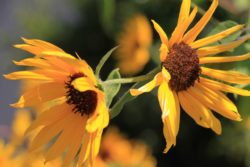
Milkweed has been planted for the endangered monarch butterfly, which lays its eggs in the garden. Yampah, the native host plant for the anise swallowtail butterfly, provides places for these lovely creatures to reproduce. Dutchman’s pipevine, the only host plant for the pipevine swallowtail butterfly was recently planted, and waits hopefully for visits from this large, iridescent blue-black butterfly.
Leaf litter is left on the ground to attract insects (which all birds need), and brush piles provide shelter for small creatures. Salamanders and newts make their homes in secluded and damp spots. Two “bee hotels” provide nesting areas for native bees; honeybees are happy in their two hives.
Adorable, native bushy-tailed gray foxes scamper about the garden—and help control rodent populations, when they are not snacking on fruit, seeds or nuts, or noshing on insects.
Woodpeckers, warblers and other songbirds flit through the trees and shrubs. Owls and hawks keep a watchful eye from overhead.
Garden Talks
11:00 and 1:00 “Are you interested in our beautiful native grasses? Join me in wandering past the nearly 20 types of water-conserving, attractive, hardy, and great-for-wildlife native grasses in my garden!) by Hope Salzer
Green Home Features
Solar panels; energy-efficient heating; Dark Skies at Night lighting (effects on wildlife); electric car; electric dryer; insulation, weather stripping and air sealing; East Bay Clean Energy 100% Clean Energy Plan; greywater system; rainwater catchment system in progress; plastic avoidance; food choices that protect the environment
Wondering what to make for dinner? Try this great recipe!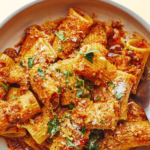
Mushroom and Caulilfower Bolognese from bon appetite
Note from Hope: “This delicious, robust, and satisfying dish is easy to make—my family loves it – even the kids!”
Keystone species (watch this talk by Doug Tallamy!)
Keystone species—our own, local ecological powerhouse plants— in this garden include oaks, holly leafed cherry, currants, California lilac, manzanitas, sages, aster, native sunflower, buckwheats, penstemon, and more.
Wheelchair Access? The front garden is wheelchair accessible.
NWF Certification? – Yes
Photos
Click to see as a slideshow:

